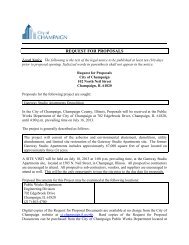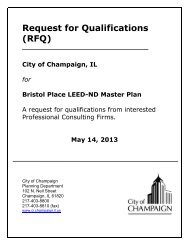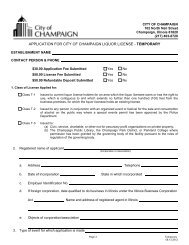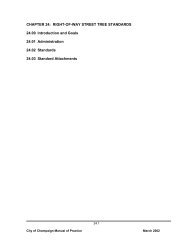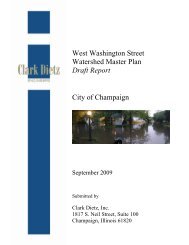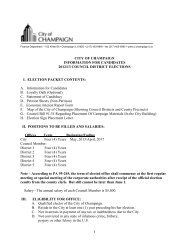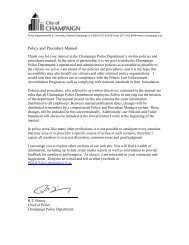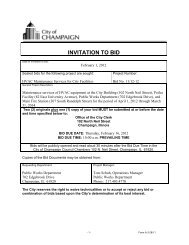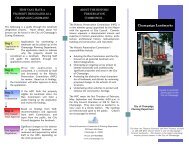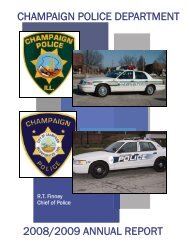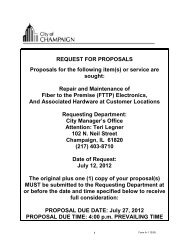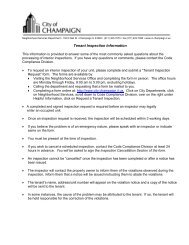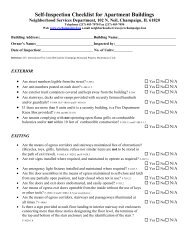2010-2014 Consolidated Plan - City of Champaign
2010-2014 Consolidated Plan - City of Champaign
2010-2014 Consolidated Plan - City of Champaign
Create successful ePaper yourself
Turn your PDF publications into a flip-book with our unique Google optimized e-Paper software.
housing units are located. The <strong>City</strong> will support efforts to improve security in public housingcomplexes to reduce crime and improve the health <strong>of</strong> the surrounding neighborhoods.b) Develop new activities to improve neighborhoods identified in the Wellness <strong>Plan</strong> as havingthe greatest need for public sector intervention. Widespread neighborhood improvement willoccur when services and resources can be concentrated in a given area over a significant period <strong>of</strong>time and are delivered as part <strong>of</strong> a well planned redevelopment strategy. Declining neighborhoodscould be revitalized with this level <strong>of</strong> intensive service delivery. However, existing communitydevelopment funding is not sufficient to address this redevelopment need.Activities:1) Acquisition/Rehab Activities: 1-2 per year (5-10 in a 5-year period). Create a pool <strong>of</strong> funding forthe <strong>City</strong> or non-pr<strong>of</strong>it housing developers to purchase and rehab vacant housing that isdeteriorated but still suitable for renovation. In addition to aggressively pursuing the acquisition <strong>of</strong>derelict properties through the court system, the <strong>City</strong> would be able to negotiate the purchase <strong>of</strong>properties from willing sellers. This activity would allow the <strong>City</strong> to react more quickly to eliminateneighborhood blight and return boarded units to the housing stock. This activity would be limitedto 2-3 projects per year and, to achieve greatest impact, would be targeted to the neighborhoodsmost in need <strong>of</strong> revitalization – such as <strong>Plan</strong>ning Areas 1 and 2. During FY 10/11, this will beaccomplished through the Neighborhood Stabilization Program funding and with HOME ($65,438HOME, $41,360 match, $34,562 program income).2) Acquisition/Clearance/New Construction: 1-2 per year (5-10 in a 5-year period). Work withhousing developers to acquire and clear dilapidated housing in Neighborhood Wellness planningareas where property values are not keeping pace with citywide values (1, 2, 6, 8, 9, 14). Toachieve greater neighborhood impact, emphasis will be placed on the clearance <strong>of</strong> adjacentproperties to assemble larger tracts <strong>of</strong> land for the development <strong>of</strong> affordable housing. Occupants<strong>of</strong> substandard housing would be relocated in accordance with federal relocation requirements.During FY 10/11, this will be accomplished through the Neighborhood Stabilization Programfunding for those areas located in the eligible area (primarily 1, 2, 8).c) Preserve the character <strong>of</strong> older neighborhoods through designation and preservation <strong>of</strong>historic properties. The <strong>Plan</strong>ning Department and Historic Preservation Commission have developeda procedure for the local designation <strong>of</strong> historic buildings and landmarks. The HPC reviewsapplications for designation and makes its recommendation to the <strong>Plan</strong> Commission and <strong>City</strong> Councilfor final designation <strong>of</strong> historic properties, landmarks, and districts. The <strong>City</strong> has been designated as aCertified Local Government through the Illinois Historic Preservation Agency, which allows the <strong>City</strong> toparticipate in the historic property review process, receive technical assistance, and apply for IHPAgrants. The IHPA reviews all federally-funded rehab projects.Activities:1) Public Education: In its public education activities, such as the annual Housing Fair, theNeighborhood Services Department will provide information about the importance <strong>of</strong> preservinghistoric or architecturally significant structures and the <strong>City</strong>’s process for reviewing sites andbuildings under its local historic preservation ordinance.2) Review <strong>of</strong> Federally-Funded Activities: Through its environmental review process, the <strong>City</strong> willensure that none <strong>of</strong> the properties approved for housing rehab assistance are listed on the nationalor local historic register. This is done by requesting an Illinois Historic Preservation Agency review<strong>of</strong> each site, prior to substantial rehab. Emergency conditions which threaten the health andsafety <strong>of</strong> occupants, or alterations that improve the home’s accessibility for a disabled owner orfamily member, may be given priority approval prior to final clearance from the IHPA. A local78 Strategic <strong>Plan</strong>: Affordable Housing



